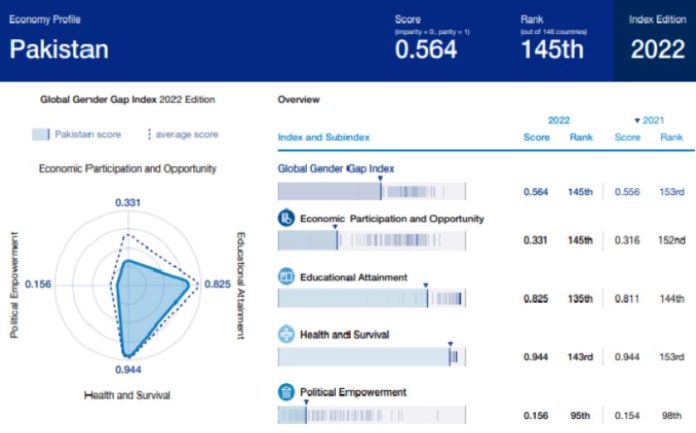Pakistan has been ranked as the second-worst country in terms of gender parity, placed 145 out of 146 states, in the latest Global Gender Gap Report released by the World Economic Forum on Wednesday.
The report ranks 146 countries, of which the top five are Iceland, Finland, Norway, New Zealand and Sweden, while the five worst ones are Afghanistan, Pakistan, Democratic Republic of Congo, Iran and Chad.
According to the report, the global gender gap has been closed by 68.1 per cent in 2022.
“At the current rate, it will take 132 years to reach full parity. This represents a slight four-year improvement compared to the 2021 estimate (136 years to parity).”
However, the report noted that in the trends leading up to 2020, the gender gap was set to close within 100 years.
Pakistan was among the five countries with a gender gap greater than 5pc, with the other countries being Qatar, Azerbaijan, China and India.
The report stated that Pakistan has closed 56.4pc of the gender gap in 2022 — the highest overall level of parity the country has posted since the report launched in 2006.
Pakistan has made “significant improvement” across three subindexes, with the highest positive variation on economic participation and opportunity, it stated.
The country ranked 145 on economic participation and opportunity, 143 on health and survival, 135 on educational attainment and 95 on political participation.
“While wage equality carries the highest gender gap score among economic indicators, advances were also reported in estimated earned income, where women’s earnings increased 4pc compared to 2021.”
However, the report noted, women’s participation in the labour force declined in 2022 and the shares of both men and women in senior and professional categories also saw a downturn.
“Gender parity scores for literacy, secondary and tertiary education enrolment all rose,” the report added.
Pakistan is the country where women have the smallest share of senior, managerial and legislative roles at a mere 4.5pc, according to the report.
Regional situation
Pakistan was also ranked as the second-worst country in the region. According to the report, Bangladesh, which is ranked 71 globally, is the top country in the region, followed by Nepal, Sri Lanka, Maldives, Bhutan, India, Iran, Pakistan and Afghanistan.
South Asia has the widest gender gap on the economic participation and opportunity subindex, having closed only 35.7pc of it, the report stated. While the overall score improved compared to last year, “considerable country divergences” downgraded South Asia’s ranking among regions.
“Highly populated countries are for the most part driving variation within this subindex. For example, increases in the share of women in professional and technical roles were most notable in Nepal, Bangladesh and India. On the other hand, the shares in Iran, Pakistan and Maldives regressed, with less impact on overall regional performance.”
South Asia has one of the lowest regional gender parity scores for the health and survival subindex, at 94.2pc., the report stated.
“In this subindex, only Sri Lanka has closed its gender gap, while Afghanistan, Pakistan and India are among the worst-performing countries globally.”
South Asia has the fourth-highest regional performance on the political empowerment subindex, having achieved 26.3pc of gender parity. The movement stems in part from the reduction of gender gap scores in countries where women’s share of years in political leadership for the past 50 years is reduced, for example in India, according to the report.
WEF Managing Director Saadia Zahidi, while commenting on the report, said “the cost of living crisis is impacting women disproportionately after the shock of labour market losses during the pandemic and the continued inadequacy of care infrastructure.
“In face of a weak recovery, government and business must make two sets of efforts: targeted policies to support women’s return to the workforce and women’s talent development in the industries of the future. Otherwise, we risk eroding the gains of the last decades permanently and losing out on the future economic returns of diversity.”

















